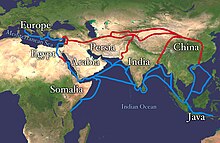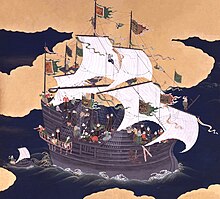History of globalization

The historical origins of
Divisions of time
Klaus Schwab, founder and Executive Chairman of the World Economic Forum, Richard Baldwin and Philippe Martin have divided the history of globalization into four eras: Globalization 1.0 was before World War I, Globalization 2.0 was after World War II "when trade in goods was combined with complementary domestic policies", Globalization 3.0, for which other terms in use have included "New Globalization", hyperglobalization, the "global value chain revolution", and the period of offshoring, refers to a more recent period of change in global economic relationships, and Globalization 4.0 to current (2018 onwards) changes affecting services in particular.[2][3]
Archaic globalization
Perhaps the extreme proponent of a
Even as early as the Prehistoric period, the roots of modern globalization could be found. Territorial expansion by our ancestors to all five continents was a critical component in establishing globalization. The development of agriculture furthered globalization by converting the vast majority of the world's population into a settled lifestyle. However, globalization failed to accelerate due to lack of long-distance interaction and technology.[5] The contemporary process of globalization likely occurred around the middle of the 19th century as increased capital and labor mobility coupled with decreased transport costs led to a smaller world.[6]

An early form of globalized economics and culture, known as
The


The advent of the
Proto-globalization
The phase is known as
The
Global integration continued with the
Modern globalization

The 19th century witnessed the advent of globalization approaching its modern form.
The inhabitant of London could order by telephone, sipping his morning tea, the various products of the whole earth, and reasonably expect their early delivery upon his doorstep. Militarism and imperialism of racial and cultural rivalries were little more than the amusements of his daily newspaper. What an extraordinary episode in the economic progress of man was that age which came to an end in August 1914.
Between the globalization in the 19th and in the 20th there are significant differences. There are two main points on which the differences can be seen. One point is the global trade in this centuries as well as the capital, investment and the economy.
- Global trade
The global trade in the 20th century shows a higher share of trade in merchant production, a growth of the trade in services and the rise of production and trade by multinational firms. The production of merchant goods in the 20th century largely decreased from the levels seen in the 19th century. However, the amount of merchant goods that were produced for the merchandise trade grew. The trade in services also grew more important in the 20th compared to the 19th century. The last point that distinguishes the global trade in the 19th century compared to the global trade in the 20th century, is the extent of multinational cooperation. In the 20th century, you can see a "quantum leap" in multinational cooperation compared to the 19th century. Before the 20th century began, there were just
Commercial integration has improved since last century, barriers that inhibit trade are lower and transport costs have decreased. Multinational trade contracts and agreements have been signed, like the General Agreement on Tariffs and Trade (GATT), North American Free Trade Agreement (NAFTA), the European Union (EU) has been hugely involved in eliminating tariffs between member states, and the World Trade Organization. From 1890 and up to World War I instability in trade was a problem, but in the post war period there has mostly been economic expansion which leads to stability. Nations have to take care of their own products; they have to make sure that foreign goods do not suffocate their domestic products causing unemployment and maybe social instability. Technological changes have caused lower transporting costs; it takes just a few hours to transport goods between continents to-day, instead of weeks or even months in the nineteenth century.
By consideration financial crisis one key difference is the monetary regime. In the 19th century it occurred under the fixed exchange rates of the gold standard. But in the 20th century it took place in a regime of managed flexibility. Furthermore, in the 19th century countries had developed effective lenders of last resort, but the same was not true at the periphery and countries there suffered the consequences. A century later there was a domestic safety net in most emerging countries so that banking panics were changed into situations where the debts of an insolvent banking system were taken over by the government. The recovery from banking crisis is another key difference. It has tended to begin earlier in the recent period than in the typical crisis episode a hundred years ago. In the 19th century there were no international rescue packages available to emerging economies. But in the recent period such rescues were a typical component of the financial landscape all over the world.
The flows information were an important downside in 19th century. Prior to the Transatlantic cable and the Radiotelephone, it used to take very long for information to go from one place to another. So this means that it was very difficult to analyze the information. For instance, it was not so easy to distinguish good and bad credits. Therefore, the information asymmetry played a very important role in international investments. The railway bonds serve as a great example. There was also many contracting problems. It was very difficult for companies working overseas to manage their operations in other parts of the world, so this was clearly a big barrier to investment. Several macroeconomic factors such as exchange risks and uncertain monetary policies were a big barrier for international investments as well. The accounting standards in the U.S. were relatively underdeveloped in the 19th century. The British investors played a very important role in transferring their accounting practices to the new emerging markets.[14]
Aftermath of World War I: collapse of globalization
The first phase of "modern globalization" began to break down at the beginning of the 20th century, with
Post-World War II: globalization resurgent
Globalization, since World War II, is partly the result of planning by politicians to break down borders hampering trade. Their work led to the
These institutions include the International Bank for Reconstruction and Development (the World Bank), and the International Monetary Fund. Globalization has been facilitated by advances in technology which have reduced the costs of trade, and trade negotiation rounds, originally under the auspices of the General Agreement on Tariffs and Trade (GATT), which led to a series of agreements to remove restrictions on free trade.
Since World War II, barriers to international trade have been considerably lowered through international agreements – GATT. Particular initiatives carried out as a result of GATT and the World Trade Organization (WTO), for which GATT is the foundation, have included:
- Promotion of free trade:
- Elimination of free trade zoneswith small or no tariffs
- Reduced transportation costs, especially resulting from development of containerization for ocean shipping.
- Reduction or elimination of capital controls
- Reduction, elimination, or harmonization of subsidies for local businesses
- Creation of subsidies for global corporations
- Harmonization of intellectual property laws across the majority of states, with more restrictions
- Supranational recognition of intellectual property restrictions (e.g. patents granted by China would be recognized in the United States)
- Elimination of
Cultural globalization, driven by communication technology and the worldwide marketing of Western cultural industries, was understood at first as a process of homogenization, as the global domination of American culture at the expense of traditional diversity. However, a contrasting trend soon became evident in the emergence of movements protesting against globalization and giving new momentum to the defense of local uniqueness, individuality, and identity.[19]
The Uruguay Round (1986 to 1994)[20] led to a treaty to create the WTO to mediate trade disputes and set up a uniform platform of trading. Other bilateral and multilateral trade agreements, including sections of Europe's Maastricht Treaty and the North American Free Trade Agreement (NAFTA) have also been signed in pursuit of the goal of reducing tariffs and barriers to trade.
World exports rose from 8.5% in 1970, to 16.2% of total gross world product in 2001.[21]
In the 1990s, the growth of low cost communication networks allowed work done using a computer to be moved to low wage locations for many job types. This included accounting, software development, and engineering design.[
Criticism
Some authors[who?] have argued that stretching the beginning of globalization far back in time renders the concept wholly inoperative and useless for political analysis.[26]
See also
References
- ^ Thomas L Friedman, "It's a Flat World, After All", New York Times Magazine, Apr 3, 2005
- ^ Schwab, K., Grappling with Globalization 4.0, published 5 November 2018, accessed 12 February 2023
- ^ Baldwin, R., If this is Globalization 4.0, what were the other three?, World Economic Forum, published 22 December 2018, accessed 12 February 2023
- ^ Andre Gunder Frank, "Reorient: Global economy in the Asian age" U.C. Berkeley Press, 1998.
- ^ Steger, Manfred (2009). "Globalization: A Very Short Introduction". Oxford University Press.
{{cite web}}: Missing or empty|url=(help) - ^ "Globalization and Development". Retrieved 4 March 2013.
- ^ Silkroad Foundation, Adela C.Y. Lee. "Ancient Silk Road Travellers". Silk-road.com. Retrieved 2010-07-31.
- ISBN 0-521-54724-5.
- ^ Jack Weatherford, Genghis Khan and the Making of the Modern World, Crown, 2004
- ^ House of India, Encyclopædia Britannica.
- ISBN 0-275-98073-1
- ^ "The Columbian Exchange Archived 2011-08-12 at the Wayback Machine". The University of North Carolina.
- ^ "PBS.org". PBS.org. 1929-10-24. Retrieved 2010-07-31.
- ^ Michael D. Bordo, Barry Eichengreen, Douglas A. Irwin. Is Globalization Today Really Different than Globalization a Hundred Years Ago?. NBER Working Paper No. 7195. June 1999.
- ^ Steger, Manfred. Globalization: A Very Short Introduction. United States: Oxford University Press Inc., New York, 2009. 28–37.
- ^ VM Yeates. Winged Victory. Jonathan Cape. London. 1962 pp. 54–55
- Journal of African History. 19.1 (1978): 11–23. Print.
- ^ Encyclopædia Britannica's Great Inventions Archived 2007-01-05 at the Wayback Machine", Encyclopædia Britannica
- ^ Jurgen Osterhammel and Niels P. Petersson. Globalization: a short history. (2005) p. 8
- ^ WTO.org,(2009)
- ^ "World Exports as Percentage of Gross World Product". Global Policy Forum. Archived from the original on 12 July 2008. Retrieved 11 November 2009.
- ^ Nouriel Roubini (January 15, 2009). "A Global Breakdown Of The Recession In 2009". Forbes.
- ^ A Global Retreat As Economies Dry Up. The Washington Post. March 5, 2009.
- ^ Economic Crisis Poses Threat To Global Stability. NPR. February 18, 2009.
- ^ "In Recession, China Solidifies Its Lead in Global Trade". The New York Times. October 13, 2009.
- ^ See Conversi, Daniele (2010) 'The limits of cultural globalisation?', Journal of Critical Globalisation Studiess, 3, pp. 36–59.
External links
- History of Globalization at Library of Congress
- [http://www.sas.upenn.edu/~dludden/global1.htm A Quick Guide to the World History of Globalisation warming
